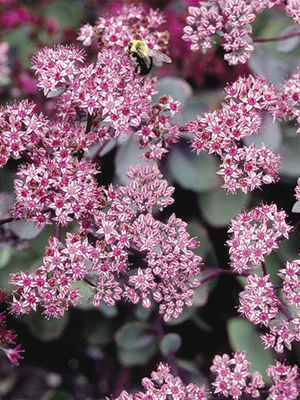1. ‘Sprite’ Astilbe

Name: Astilbe ‘Sprite’
USDA hardiness zones: 4 to 8
Size: Up to 2 feet tall and 3 feet wide
Conditions: Full sun to full shade; moist, humus-rich soil
This graceful astilbe features vertical spires of pink flowers that offer three-dimensional interest, whereas many other ground covers simply form a one-dimensional mat on the garden floor. While ‘Sprite’ can tolerate full sun, it will maintain its flowers for a longer time if planted in a shady, moist environment. After the flowers lose their color in early fall, the rusty-hued seed heads offer rich textural interest that lasts into winter.
2. European Wild Ginger

Name: Asarum europaeum
Zones: 4 to 8
Size: 3 inches tall and 1 foot wide
Conditions: Partial to full shade; fertile, moist, well-drained soil
Low-growing European wild ginger is a true favorite for dark areas that need a little light, thanks to its round, glossy leaves that grow into a dense light-reflective mat. The springtime flowers are nice but rather inconspicuous; it’s the dark green foliage that provides interest. European wild ginger’s lush leaves would lead one to assume that the plant requires lots of water and attention to keep pristine. This is not the case. I once noticed a forgotten pot, left unwatered at the height of summer, survive when most other perennials would have withered.
3. ‘Vera Jameson’ Sedum

Name: Sedum ‘Vera Jameson’
Zones: 4 to 9
Size: Up to 1 foot tall and 18 inches wide
Conditions: Full sun to partial shade; well-drained soil
‘Vera Jameson’ sedum became one of my favorite plants in 2012 because it tolerated the harshest conditions I could have possibly given it: hot and dry weather and poor sandy soil to grow in. Thankfully, the plant thrived. ‘Vera Jameson’ requires little attention and creeps quite happily over the nooks and crannies of a rock garden. The dark pink to purple foliage provides deep contrast to neighboring plants and blends in nicely with the grays and blues of many of our native New England stones.
4. ‘Crispa’ Cutleaf Stephanandra

Name: Stephanandra incisa ‘Crispa’
Zones: 3 to 8
Size: 2 feet tall and 10 feet wide
Conditions: Full sun to partial shade; moist, well-drained soil
This plant can cover up large areas and steep rocky inclines common in Vermont’s landscape. The kelly green foliage of ‘Crispa’ cutleaf stephanandra is quick to appear in spring, and the branches spread quickly via suckers. Planted en masse, the plant undulates and gives the impression that the ground is mounded. While hardy and easy to establish, the genus Stephanandra can be temperamental in a pot: The plants dry out quickly, so get them into the ground as soon as possible.
Ian Ambler is a landscape architect and the owner of Ambler Design in Stowe, Vermont.
Photos: #1, courtesy of bluestoneperennials.com; #2, Michelle Gervais; #3, Bill Johnson; #4, Jennifer Benner

















Comments
Log in or create an account to post a comment.
Sign up Log in